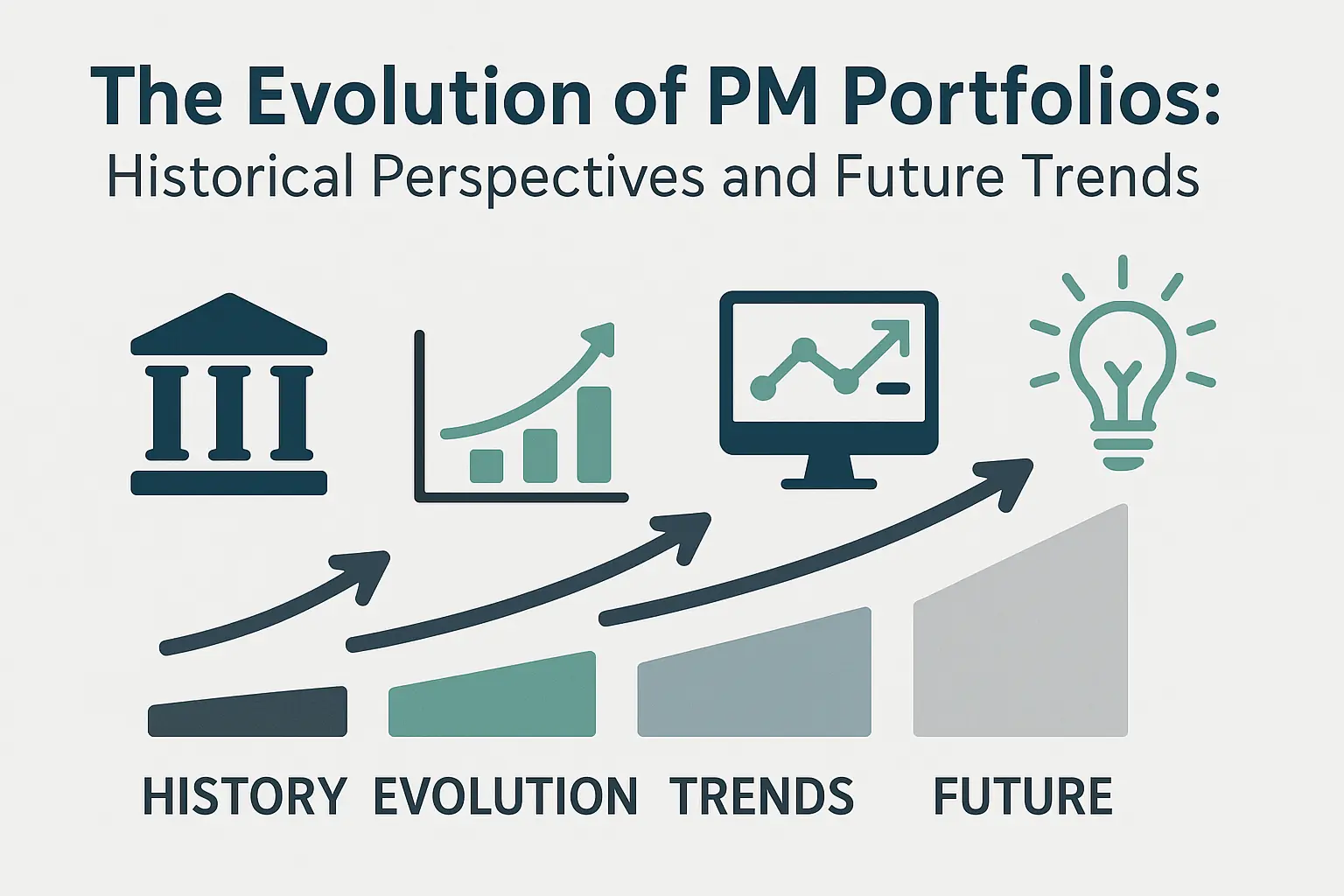Introduction
A Project Management (PM) portfolio serves as a vital tool that encapsulates a project manager’s skills, experiences, and achievements. It is a curated collection of work samples, project summaries, and artifacts that not only showcase a professional’s capabilities but also reflect their strategic approach to managing projects. The significance of a PM portfolio lies in its ability to communicate a project manager’s value to potential employers, stakeholders, and clients, thereby enhancing career opportunities and fostering professional growth [1][10].
Understanding the historical perspectives of PM portfolios is crucial for project management professionals and historians alike. Over the years, the methodologies, tools, and practices associated with project management have evolved significantly, influenced by technological advancements, changing organizational needs, and emerging trends. By examining the evolution of PM portfolios, we can gain insights into how project management has transformed and how these changes have shaped the competencies required for success in the field. This retrospective analysis not only highlights past achievements but also sets the stage for anticipating future trends that will continue to redefine the landscape of project management [2][6].
This blog post will be structured as follows:
– Historical Overview: A look back at the development of PM portfolios, including key milestones and shifts in practices.
– Current Trends: An exploration of contemporary practices in PM portfolios, focusing on the integration of technology and evolving methodologies.
– Future Directions: Insights into how PM portfolios are expected to evolve in the coming years, considering factors such as automation, artificial intelligence, and the increasing importance of soft skills in project management [4][7][11].
By delving into these key areas, we aim to provide a comprehensive understanding of the evolution of PM portfolios, equipping project management professionals with the knowledge to adapt and thrive in an ever-changing environment.
Historical Context of PM Portfolios
The evolution of project management (PM) portfolios is a fascinating journey that reflects the broader changes in the field of project management itself. Understanding this historical context is essential for project management professionals and historians alike, as it provides a foundation for appreciating current practices and anticipating future trends.
- Early Days of Project Management: In the initial stages of project management, particularly before the mid-20th century, there was a notable absence of structured portfolios. Projects were often managed in isolation, with little consideration for how they fit into a larger organizational strategy. This lack of a cohesive approach meant that project selection and prioritization were largely ad hoc, leading to inefficiencies and missed opportunities for synergy among projects.
- Emergence as a Discipline: The mid-20th century marked a significant turning point for project management as it began to emerge as a distinct discipline. This period saw the introduction of formal methodologies and frameworks that laid the groundwork for structured project management practices. The development of tools such as the Gantt chart and the Critical Path Method (CPM) provided project managers with the means to plan and execute projects more effectively. As organizations recognized the value of managing multiple projects simultaneously, the concept of project portfolios began to take shape.
- Key Milestones in Development: Several key milestones have defined the evolution of PM portfolios over the decades. The establishment of project portfolio management (PPM) methodologies in the late 20th century was a critical development. These methodologies emphasized the importance of aligning projects with organizational strategy, optimizing resource allocation, and managing risks across the portfolio. The introduction of frameworks such as the Project Management Institute’s (PMI) Portfolio Management Standard further formalized the discipline, providing guidelines for best practices in portfolio management.
As we reflect on the historical context of PM portfolios, it becomes clear that the evolution of project management has been marked by a gradual shift from isolated project management practices to a more integrated and strategic approach. This retrospective view not only highlights the significant advancements made in the field but also sets the stage for exploring future trends that will continue to shape project portfolio management.
The 1980s and 1990s: Formalization and Standardization
The evolution of project management portfolios during the 1980s and 1990s marked a significant shift towards formalization and standardization, driven by the growing complexity of projects and the need for structured methodologies. This period laid the groundwork for modern project portfolio management (PPM) practices, influenced by several key factors:
- Impact of Organizations like PMI and the Introduction of PMBOK: The Project Management Institute (PMI) played a pivotal role in the formalization of project management practices during this era. The introduction of the Project Management Body of Knowledge (PMBOK) in the late 1980s provided a standardized framework that outlined best practices, processes, and terminologies essential for effective project management. This framework not only enhanced the credibility of the profession but also facilitated a common understanding among project managers, leading to more consistent and effective portfolio management practices across organizations [5][12].
- Role of Technology in Portfolio Management: The 1980s and 1990s also witnessed the advent of early software solutions designed to assist in project portfolio management. These tools began to automate various aspects of project tracking, resource allocation, and reporting, which were previously managed manually. The integration of technology into portfolio management allowed organizations to handle larger and more complex portfolios with greater efficiency. As software solutions evolved, they provided project managers with enhanced capabilities for data analysis and decision-making, further solidifying the importance of standardized practices in managing project portfolios [6][14].
- Case Studies of Successful Implementation: Numerous organizations began to recognize the benefits of formalized project portfolio management during this period. For instance, companies that adopted PMBOK guidelines and invested in portfolio management software reported improved project outcomes, better resource utilization, and enhanced alignment of projects with strategic objectives. Case studies from this era highlight how organizations like IBM and Boeing successfully implemented structured portfolio management processes, leading to increased project success rates and more effective governance of project investments. These examples serve as a testament to the value of formalization and standardization in project management portfolios [4][12].
The 2000s: Expansion and Diversification
The 2000s marked a significant turning point in the evolution of project management (PM) portfolios, characterized by an expansion in the types of projects managed and the methodologies employed. This era witnessed the rise of agile methodologies, diversification of project types, and an increased focus on stakeholder management and governance.
Rise of Agile Methodologies
The introduction and subsequent adoption of agile methodologies during the 2000s fundamentally transformed how project portfolios were managed. Agile approaches, which emphasize flexibility, iterative progress, and customer feedback, allowed organizations to respond more effectively to changing market demands and project requirements. This shift not only improved project outcomes but also necessitated a reevaluation of portfolio management practices to accommodate the dynamic nature of agile projects. As a result, project managers began to integrate agile principles into their portfolios, leading to a more adaptive and responsive management style that could handle the complexities of modern projects [6][8].
Diversification of Project Types
During this decade, project portfolios expanded to include a broader array of project types, such as information technology (IT), construction, research and development (R&D), and more. This diversification was driven by the increasing complexity of business environments and the need for organizations to innovate and remain competitive. As companies sought to leverage different project types to achieve strategic objectives, portfolio management practices evolved to ensure that diverse projects could be effectively prioritized, monitored, and aligned with organizational goals. This shift required project managers to develop a more nuanced understanding of various industries and project methodologies, enhancing their ability to manage a wide range of initiatives within a single portfolio [5][10].
Growing Importance of Stakeholder Management and Governance
The 2000s also saw a heightened emphasis on stakeholder management and governance within project portfolios. As projects became more complex and interconnected, the need for effective stakeholder engagement grew. Project managers were tasked with not only delivering projects on time and within budget but also ensuring that the interests and expectations of various stakeholders were met. This led to the development of more robust governance frameworks that facilitated better decision-making and accountability within project portfolios. Organizations began to recognize that effective governance was essential for managing risks and ensuring that projects contributed to overall strategic objectives [9][12].
The 2010s: Integration with Strategic Management
The 2010s marked a significant turning point in the evolution of project management (PM) portfolios, as organizations began to recognize the critical importance of aligning their project portfolios with overarching business strategies. This integration not only enhanced the effectiveness of project management practices but also ensured that resources were allocated in a manner that maximized value delivery to both the organization and its stakeholders.
Strategic Portfolio Management: A Conceptual Overview
Strategic portfolio management emerged as a vital discipline during this decade, emphasizing the alignment of project selection and prioritization with the strategic objectives of the organization. This approach shifted the focus from merely completing projects on time and within budget to ensuring that each project contributed to the long-term goals of the organization. The integration of PM portfolios with strategic management allowed organizations to navigate complex environments and respond to changing market demands more effectively [3][8].
Tools and Frameworks for Integration
To facilitate this integration, various tools and frameworks were developed and adopted by organizations. These included:
- Balanced Scorecard: This framework helped organizations translate their strategic objectives into actionable projects, ensuring that project portfolios were aligned with business goals.
- Project Portfolio Management (PPM) Software: Advanced PPM tools provided organizations with the ability to visualize their project portfolios, assess their alignment with strategic objectives, and make data-driven decisions regarding project prioritization and resource allocation.
- Agile Methodologies: The adoption of agile practices allowed organizations to remain flexible and responsive to changes in strategy, enabling them to adjust their project portfolios in real-time based on evolving business needs [2][9].
Real-World Examples of Strategic Alignment
Several organizations successfully leveraged their PM portfolios for strategic alignment during the 2010s:
- General Electric (GE): GE implemented a robust PPM framework that aligned its project initiatives with its strategic vision of innovation and sustainability. By prioritizing projects that supported these goals, GE was able to enhance its competitive advantage and drive growth.
- Procter & Gamble (P&G): P&G utilized strategic portfolio management to streamline its product development processes. By aligning its project portfolio with consumer insights and market trends, P&G was able to launch successful products that resonated with customers and contributed to its bottom line.
- IBM: IBM adopted an integrated approach to project management that emphasized the alignment of its technology initiatives with business strategy. This approach allowed IBM to focus on high-impact projects that supported its transformation into a cloud and AI-driven organization [8][11].
Current Trends in PM Portfolios
The landscape of project management portfolios is undergoing significant transformation, influenced by various contemporary trends. This section outlines the key factors shaping the future of PM portfolios, providing insights for project management professionals and historians alike.
Influence of Digital Transformation and Data Analytics
Digital transformation is revolutionizing project portfolio management (PPM) by enhancing decision-making capabilities and improving resource management. The integration of advanced data analytics allows project managers to gain deeper insights into project performance, enabling more informed decisions regarding project selection and prioritization. This shift towards data-driven decision-making is crucial as organizations strive for greater transparency and efficiency in managing their portfolios. The ability to analyze real-time data not only aids in tracking progress but also helps in forecasting potential risks and opportunities, thereby optimizing overall portfolio performance [2][9].
Rise of Remote Work and Virtual Project Environments
The rise of remote work has fundamentally altered the dynamics of project management. With teams increasingly distributed across various locations, project managers are adapting to virtual project environments that require new strategies for collaboration and communication. This shift has led to the adoption of collaborative tools and technologies that facilitate seamless interaction among team members, regardless of their physical location. As a result, project portfolios are now being managed with a focus on flexibility and adaptability, allowing organizations to respond swiftly to changing circumstances and maintain productivity in a hybrid work model [5][13].
Increasing Focus on Sustainability and Social Responsibility
In recent years, there has been a growing emphasis on sustainability and social responsibility in project selection. Organizations are increasingly prioritizing projects that align with their corporate social responsibility (CSR) goals and contribute positively to the environment and society. This trend reflects a broader societal shift towards sustainability, where stakeholders expect businesses to operate ethically and responsibly. As a result, project portfolios are being evaluated not only on financial metrics but also on their potential social and environmental impact. This holistic approach to project selection is reshaping the criteria for portfolio management, ensuring that organizations contribute to sustainable development while achieving their strategic objectives [2][14].
Future Directions and Predictions
The landscape of project management portfolios is poised for significant transformation, driven by technological advancements and the evolving global context. Here are some key trends and predictions that will shape the future of PM portfolios:
- Advancements in Technology: The integration of Artificial Intelligence (AI) and Machine Learning (ML) is set to revolutionize project portfolio management. These technologies will enhance decision-making processes by providing data-driven insights, automating routine tasks, and enabling predictive analytics. As organizations increasingly adopt AI-driven tools, project managers will be able to optimize resource allocation, assess project risks more effectively, and improve overall portfolio performance [6][13].
- Global Challenges and Their Implications: The impact of global challenges, such as climate change and economic shifts, will necessitate a reevaluation of project portfolios. Organizations will need to prioritize sustainability and resilience in their project selection and management processes. This shift will likely lead to the development of portfolios that not only focus on financial returns but also consider environmental and social impacts, aligning with broader corporate social responsibility goals [4][15].
- Fostering Innovation and Adaptability: As the business environment becomes increasingly volatile, the role of PM portfolios in fostering innovation and adaptability will become more pronounced. Organizations will need to cultivate a culture of flexibility, allowing for rapid adjustments to project priorities in response to changing market conditions. This adaptability will be crucial for maintaining competitive advantage and driving innovation, as project managers will be tasked with balancing traditional methodologies with agile approaches to meet diverse project demands [8][12].
Conclusion
The evolution of project management (PM) portfolios has been a significant journey, reflecting the broader changes in the field of project management itself. Over the decades, PM portfolios have transitioned from rudimentary collections of projects to sophisticated systems that strategically align with organizational goals. This historical journey underscores the importance of PM portfolios in enhancing resource allocation, risk management, and overall project success.
Key insights from this evolution include:
- Historical Significance: The development of PM portfolios has paralleled advancements in project management methodologies and technologies. From the early days of project management, where the focus was primarily on individual projects, to the modern emphasis on portfolio management that optimizes the mix of projects, the historical context provides valuable lessons for current practices [1][10].
- Adaptation to Trends: As project management continues to evolve, professionals must remain agile and responsive to emerging trends. This includes embracing data-driven decision-making, leveraging technology for better visibility across portfolios, and understanding the importance of aligning projects with strategic objectives. By staying informed about these trends, project managers can better prepare for future changes and enhance their portfolio management practices [6][9].
In summary, understanding the historical evolution of PM portfolios is crucial for project management professionals. It not only highlights the importance of these portfolios in achieving project success but also encourages a proactive approach to adapting to future trends. By reflecting on the past and engaging with peers, we can collectively enhance our practices and contribute to the ongoing development of project management as a discipline.
Find out more about Shaun Stoltz https://www.shaunstoltz.com/about/.
This post was written by an AI and reviewed/edited by a human.



